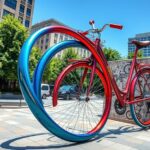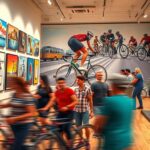The intersection of art and cycling is rich with creative expressions that celebrate movement, innovation, and community. From historic artworks inspired by racing to contemporary installations, artists use bikes and related imagery to explore identity, progress, and sustainability. Public art projects incorporate bike-themed murals, sculptures, and urban design to enhance safety and community pride. If you explore further, you’ll discover how these creative efforts reshape urban spaces and inspire new ways to experience and enjoy cycling.
Key Takeaways
- Artists incorporate cycling themes through paintings, sculptures, and digital art, capturing motion, speed, and modern life.
- Public art projects, murals, and street installations use bicycles to enhance community engagement and promote safety.
- Exhibitions showcase cycling history and culture, blending vintage artifacts with contemporary works inspired by bikes.
- Creative events like pedal-powered art and virtual bike exhibitions make cycling an interactive, artistic experience.
- Design innovations in bike infrastructure and functional art merge utility with aesthetic expression, symbolizing cycling’s cultural significance.
Artistic Depictions of Cycling Through History
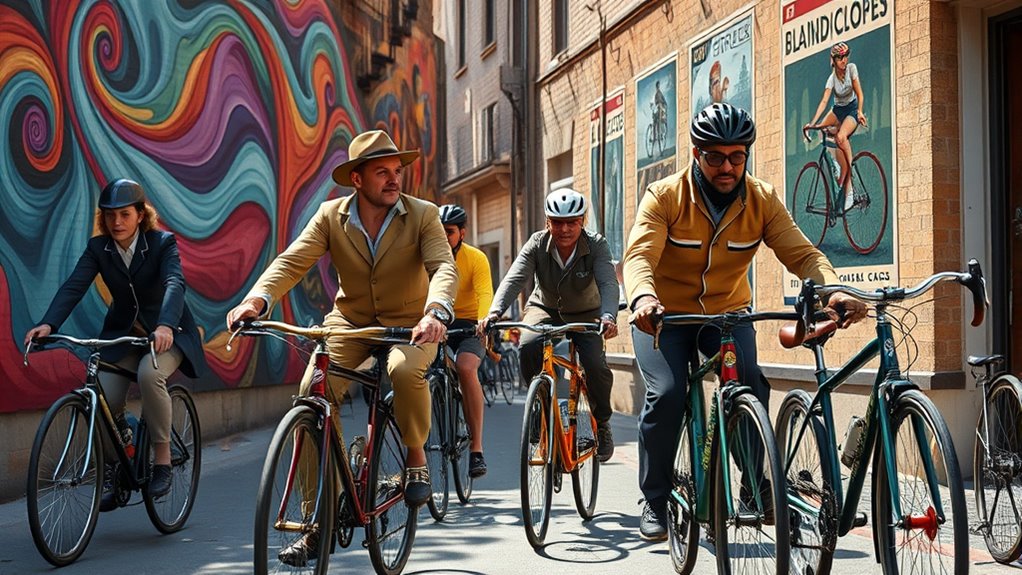
Throughout history, artists have captured the dynamic spirit of cycling, transforming it into a powerful symbol of modernity and movement. During the early 20th century, movements like Cubism and Futurism emphasized speed and progress through fragmented forms and abstract motion. Umberto Boccioni’s *Dynamism of a Cyclist* exemplifies Futurist ideals, portraying motion in an abstract way. Jean Metzinger’s *At the Cycle-Race Track* used geometric shapes to depict racing scenes, while Lyonel Feininger’s *The Bicycle Race* combined crowded compositions with angular figures. Natalia Goncharova’s *The Cyclist* blended Russian avant-garde styles with cycling themes. These works celebrate the energy of cycling, highlighting its role as a symbol of modern life and technological advancement. The Pinball Spot offers a nostalgic look at classic arcade games that also reflect the innovative spirit of their respective eras. Additionally, the depiction of cycling in art underscores its significance as a cultural icon, representing progress and human ingenuity across different periods.
Contemporary Exhibitions Celebrating Bicycle Culture
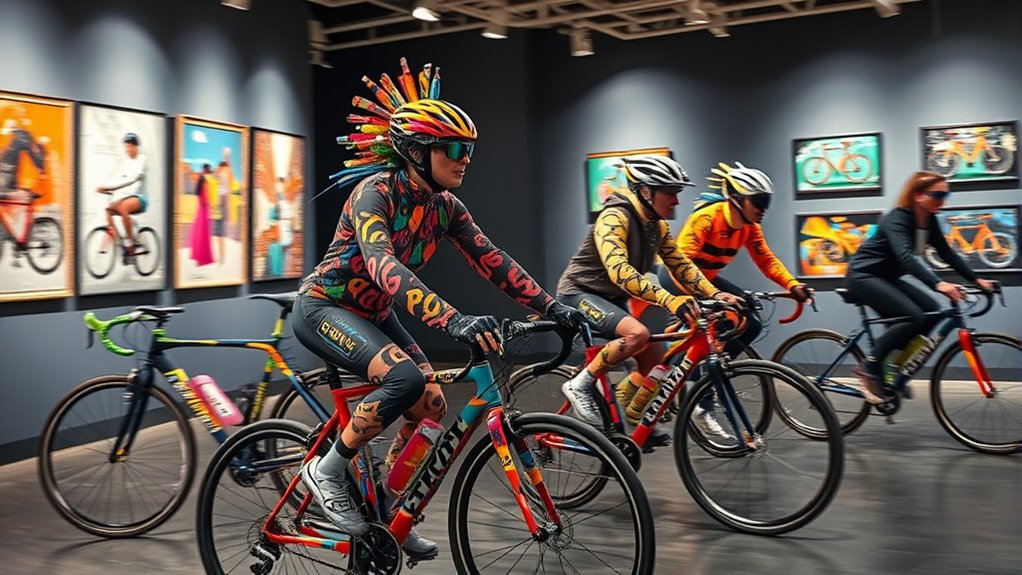
Contemporary art exhibitions increasingly celebrate bicycle culture as a reflection of societal values and technological progress. At The Aldrich, *Bike Rides* showcases customized bikes by artists and designers, exploring identity and function while highlighting bicycles as symbols of sustainability and urban transformation. Eye patches are also used in some exhibitions to explore themes of aging and beauty, linking health and aesthetics to personal identity. Large-scale shows like *Cycle Thru!* at Cincinnati Art Museum combine artifacts, design objects, and modern art, engaging visitors with videos and workshops that connect cycling history to contemporary issues. The *RE: BICYCLING* exhibit at Inglett Gallery presents works from 1895 to 2021, emphasizing bicycles’ role in personal and political freedom through diverse media. Meanwhile, EPO1 Gallery’s *Ride* transforms a former power plant into a monumental space, featuring sculptures, trophies, and photography, broadening cycling’s cultural appeal and fostering community engagement through sport-art integration. Additionally, incorporating creative expressions into cycling exhibitions highlights how art can elevate the cultural significance of bicycles beyond mere transportation. Promoting biodiversity-friendly practices in urban cycling infrastructure can also enhance local ecosystems and support backyard biodiversity, aligning with the societal shift towards sustainability and environmental awareness emphasized in Knowledge. Recognizing bicycles as tools for promoting mental well-being further enriches their cultural and social importance within contemporary art.
Urban Art Initiatives Enhancing Cycling Safety
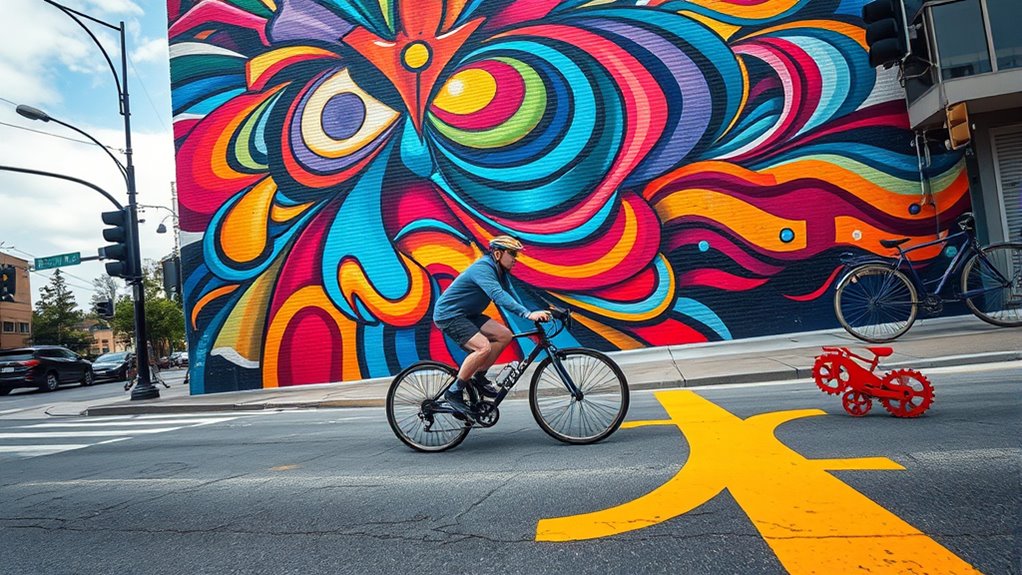
Urban art initiatives are transforming cycling safety by integrating creative visual elements into city streets, which effectively calms traffic and reduces crashes. Street murals at intersections have led to a 50% drop in crashes involving pedestrians and cyclists, while injury-causing crashes decreased by 37%.
Clearer crosswalks and artistic cues increase pedestrian safety, resulting in 25% fewer conflicts and a 27% rise in drivers yielding to pedestrians. These visual cues also slow traffic, with a 17% overall crash reduction across all vehicles.
Behavioral changes include a 38% decline in jaywalking and improved driver alertness. Cities like NYC and Washington D.C. use curb extensions, bike racks, and utility box art to bypass regulations while promoting safety.
These low-cost, scalable initiatives foster community ownership, making streets safer for everyone.
Mixed-Media Creations Inspired by Bicycles

Mixed-media creations inspired by bicycles combine diverse artistic techniques to celebrate cycling’s cultural and environmental significance. You might see artists integrating bicycle parts with paper, fabric, or recycled materials, creating striking collages. These sustainable materials emphasize the importance of recycling in art, promoting eco-conscious practices through creative expression. Layered textures using acrylics, inks, and found objects mimic urban landscapes or mechanical details. Digital-art hybrids blend traditional painting with graphic design, producing vibrant cycling-themed prints. Artists repurpose chains, gears, and frames into sculptures, emphasizing sustainability. The themes explore motion through dynamic brushstrokes or geometric patterns, evoke vintage nostalgia with sepia tones and typography, or highlight ecological messages by incorporating natural textures like leaves and bark. In addition, understanding the contrast ratio of projectors can help artists showcase their work with better depth and clarity during exhibitions, enhancing viewer engagement. For example, integrating visual contrast techniques can make cycling motifs stand out more vividly. Incorporating artistic techniques such as collage and mixed media allows for innovative visual storytelling that reflects cycling’s diverse cultural landscape. These artworks often reflect cycling subcultures and cityscapes, engaging viewers with innovative visuals that honor cycling’s cultural roots and eco-conscious spirit. Moreover, embracing space maximization in presentation setups can further elevate the visual impact of these mixed-media pieces, creating immersive experiences for viewers.
Community Projects Merging Art and Pedestrian Mobility
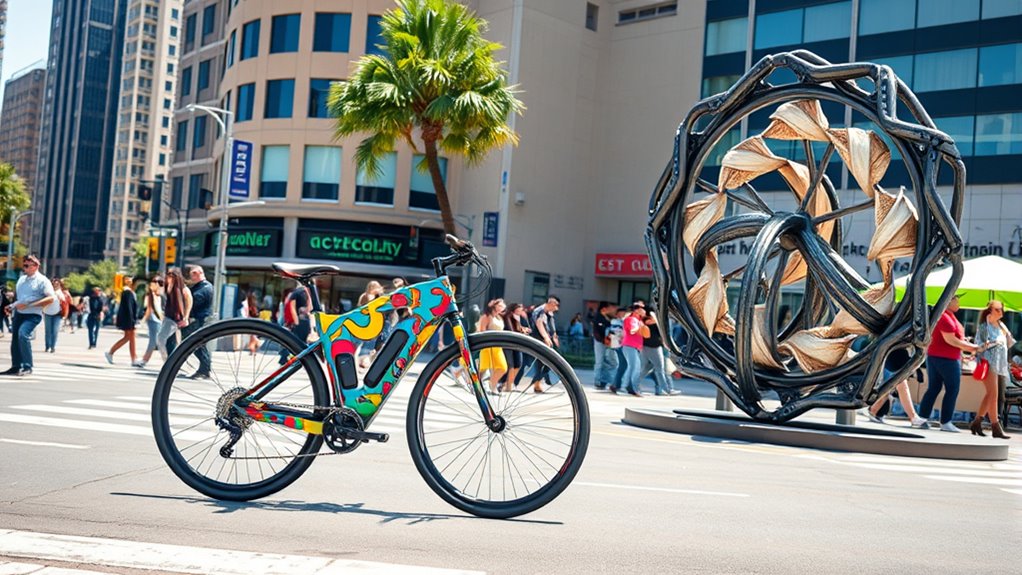
Community projects that merge art and pedestrian mobility transform city streets into vibrant, engaging spaces by combining creative expression with practical safety features. You’ll see colorful crosswalk murals that boost visibility and safety while fostering community pride. Local artists often lead these projects through open calls, ensuring designs reflect neighborhood identities—like Syracuse’s plaza, which involved over 850 residents. These painted zones not only calm traffic but also reduce accidents, making streets safer for everyone. Volunteer efforts, such as Syracuse’s five-day mural, mobilize residents and strengthen bonds. Urban planners sometimes convert these painted areas into car-free zones, promoting walkability and local culture. Incorporating butter into community art projects can also serve as an innovative way to support local partnerships and foster creative engagement. Additionally, integrating data privacy considerations ensures that these initiatives respect community members’ rights while enhancing urban aesthetics. Emphasizing community involvement is essential for the success and sustainability of such projects, fostering a sense of ownership and pride among residents. Moreover, leveraging public art can attract tourism and stimulate local economies, further reinforcing community bonds.
Iconic Artists Who Explore Cycling in Their Work
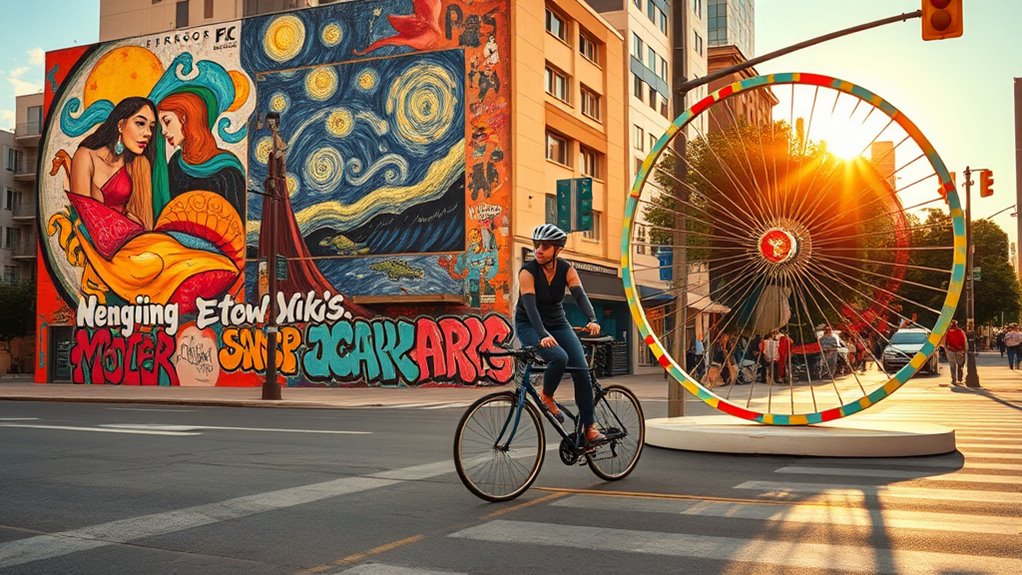
Artists have long found inspiration in cycling, capturing its energy and movement through diverse styles and techniques. Michael Valenti blends modern digital prints with classic race posters, highlighting iconic races and places. The Handmade Cyclist tells contemporary stories through posters and ceramics inspired by cycling legends. Shan Jiang creates detailed illustrations commissioned for cycling journals, adding depth to the sport’s visual narrative.
Lucy Pittaway’s cycling collection features unique proofs and originals, appealing to collectors. British painter Robert Medley, active in the 1950s, depicted cycling scenes in pastoral settings, emphasizing motion. Influenced by movements like Cubism and Futurism, artists like Umberto Boccioni and Jean Metzinger explored cycling’s dynamism.
These creators celebrate cycling’s energy, blending tradition with innovation in their artistic expressions.
The Role of Bikes in Public Art and Street Installations
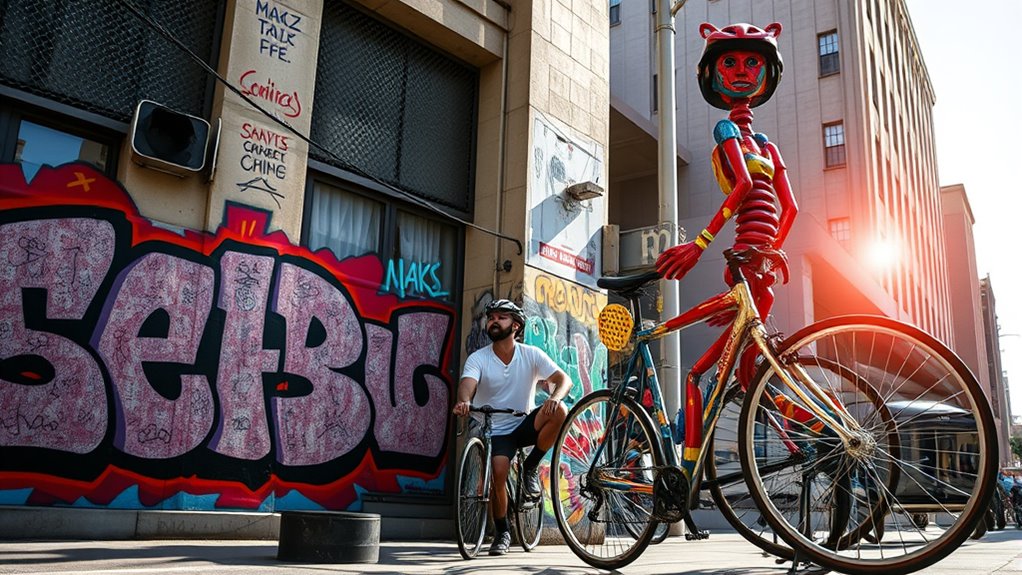
Bikes have become powerful symbols in public art and street installations, transforming everyday transportation into engaging visual experiences. You’ll see bike racks designed as functional art, like Philadelphia’s “Gilded Gates,” blending utility with beauty. City initiatives, funded by grants like those from the Knight Foundation, incorporate local artists into bike infrastructure, creating community-driven designs that encourage participation. Modular racks invite community interaction through daily use, fostering a sense of ownership. Local artists in Sarasota decorate bikes with cultural motifs, sparking public engagement and recurring interest. Large-scale installations, such as Ai Weiwei’s “Forever Bicycles,” critique societal issues and symbolize interconnectedness. These projects turn bikes into powerful symbols, not only for mobility but also for civic pride, cultural commentary, and social dialogue. Incorporating mindfulness and presence into design processes enhances the emotional impact of public art, fostering deeper connections between communities and their environments. Additionally, integrating artistic expression into bike design can elevate street aesthetics and inspire community pride, reflecting the importance of community engagement in successful public art initiatives. Recognizing the artistic potential of bikes encourages ongoing innovation and cultural relevance in urban design.
The Evolution of Bicycle-Inspired Visual Styles

The visual styles inspired by bicycles have evolved dramatically over time, reflecting shifts in technology, culture, and design trends. You can see this transformation from the early Velocifere, with its simple wooden frame and no pedals, to the lightweight Laufmaschine with larger wheels. During the Victorian era, bikes like the “Bone Shakers” and Penny-Farthings showcased bold iron frames and oversized wheels, emphasizing speed and status. The 1885 safety bicycle introduced a more practical, standardized look with equal-sized wheels and chain drives, symbolizing gender emancipation and mass appeal. Moving into the late 20th century, vibrant BMX colors and rugged mountain bikes reflected subcultural identity. Today, sleek carbon fiber frames, integrated e-bike designs, and retro-modern hybrids highlight minimalist aesthetics, blending innovation with vintage influences. Additionally, the evolution of bicycle design has been influenced by design trends, which continue to shape modern aesthetics and functionalities.
Interactive and Participatory Art Events Focused on Cycling

Interactive and participatory art events centered on cycling are transforming how communities engage with mobility and creativity. Virtual exhibitions like the Bike, Art, City showcase allow audiences from Namibia, Morocco, Iraq, Peru, and India to explore sustainable mobility through 3D virtual installations, reducing the carbon footprint of physical art transport.
In museums, cycling history blends with contemporary art in exhibits like Cycle Thru!, pairing vintage bicycles with works by Ader and Kumar, and encouraging visitors to arrive by bike with selfie verification.
Kinesthetic experiences such as Spin Art turn cycling into artistic expression, inviting everyone to pedal and create vibrant paintings. These events foster hands-on involvement, making art and cycling accessible, fun, and meaningful while highlighting themes of sustainability, urban infrastructure, and community dialogue.
Future Trends: Art, Design, and the Bicycle in Urban Spaces
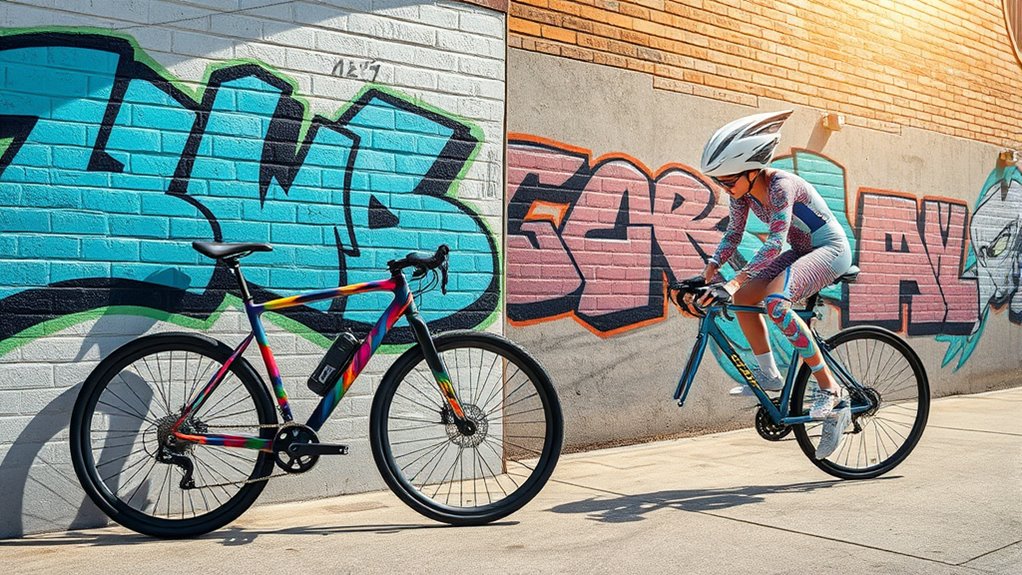
As cities aim to make cycling an integral part of urban life, innovative art and design initiatives are shaping the future of bicycle integration. Bicycle Architecture Biennale projects focus on blending functionality with aesthetic appeal, creating elevated paths, creative parking solutions, and vibrant routes to weave cycling into city fabric.
Graffiti and street art now transform bikes and infrastructure into dynamic urban canvases, symbolizing culture and advocacy. Technological innovations, like sensor-equipped paths and augmented reality overlays, enhance safety and rider experience, while modular bike racks serve as public art.
Urban planning increasingly prioritizes safe lanes, ample parking, and traffic-calmed zones to embed cycling into daily life. These trends, driven by global models like Amsterdam and NYC, are redefining how art, design, and cycling coexist in future cityscapes.
Frequently Asked Questions
How Has Cycling Influenced Contemporary Street Art and Graffiti Movements?
You see how cycling has shaped contemporary street art and graffiti by inspiring vibrant murals and graffiti that celebrate urban culture. Bicycles often become central themes, symbolizing freedom, movement, and sustainability.
As you explore city streets, you notice how artists use bikes to connect with communities, promote cycling, and transform urban landscapes into lively galleries. This dynamic blend of art and cycling encourages interaction, creativity, and a shared sense of identity.
What Cultural Differences Shape Bicycle-Themed Artwork Worldwide?
You see that cultural differences deeply influence bicycle-themed artwork worldwide. In the Netherlands, it’s about family and practicality, reflecting their bike-centric lifestyle.
In Japan, traditional aesthetics and craftsmanship shape illustrations like Ohno’s work, emphasizing precision.
Chinese art often critiques rapid urbanization, repurposing bikes for political statements.
Meanwhile, Western markets focus on lifestyle branding, and street art adapts local aesthetics—geometric or photorealistic—highlighting each society’s unique relationship with cycling.
How Do Artists Address Environmental Concerns Through Cycling-Inspired Art?
You see that artists use cycling-inspired art to highlight environmental concerns by incorporating recycled materials like bike parts into sculptures, emphasizing reuse and sustainability.
They create nature-themed works to raise awareness about preserving ecosystems, and develop installations like solar system models to promote environmental understanding.
Community involvement is key, as collaborative projects foster engagement and inspire action.
Through these creative expressions, artists communicate the importance of protecting our planet while celebrating cycling’s role in sustainability.
In What Ways Do Cycling Festivals Incorporate Visual Arts and Performances?
You’ll find cycling festivals beautifully blend visual arts and performances by showcasing art installations, curated film programs, and live music. You can participate in guided art rides, watch illuminated night displays, or enjoy performances by musicians and performers alongside bike parades.
These events often feature community-driven workshops, interactive exhibits, and collaborations with artists, creating dynamic, multisensory experiences that celebrate cycling’s artistic and cultural possibilities.
How Can Bike Design Inspire New Forms of Artistic Expression?
You can explore how bike design sparks new artistic forms by experimenting with vibrant paint jobs that reflect themes like freedom and movement. Use sculptural components like wheels and handlebars to create three-dimensional art, or incorporate innovative tech such as LED lights and augmented reality overlays.
Conclusion
As you explore the vibrant dance between art and cycling, you’ll find it softly weaving through history and innovation. These gentle strokes and subtle movements inspire a sense of harmony, inviting you to see wheels and walls as partners in creative expression. Embrace this evolving journey, where every turn and brushstroke quietly enriches your experience, reminding you that the beauty of art and cycling is a delicate, ongoing conversation shaping our shared urban story.



